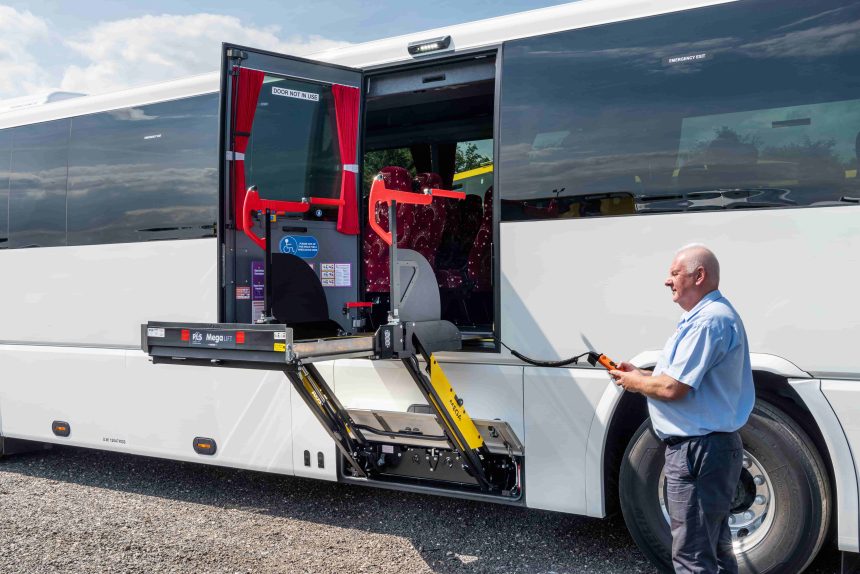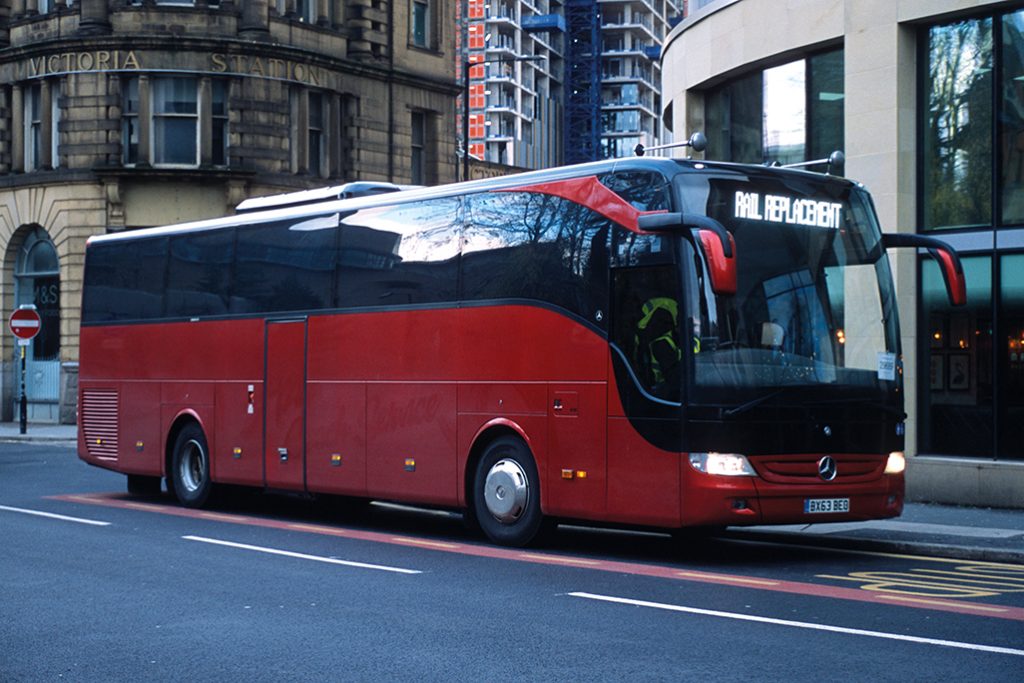PSVAR. Has any other topic managed to drive so much discourse among coach sector professionals?
For the last three years, debate has been dominated by the medium-term exemptions (MTEs) introduced for (in-scope) home-to-school and rail replacement duties back in 2022 — a white flag from the Department for Transport (DfT) recognising that there was no way (then) of meeting demand for the compliance targets.
That solution met with mixed reactions when introduced — even condemned by one operator as a “crazy situation”. For that company and others like it, exemptions represented a dismissal of time and expense invested into being prepared for what had been a long time coming. The Confederation of Passenger Transport took a diplomatic approach, saying the exemptions struck “a reasonable balance” between those operators that had made investments to comply, and those that had struggled financially through the COVID-19 pandemic.
Now, the exemptions, with their incremental ‘full’ and ‘partial’ compliance categories, varying fleet band sizes and percentage expectations, expire in just over a year. What comes after? No-one outside of the government, it seems, knows. But the UK Coach Operators Association (UKCOA), which has long been vocal on the subject, is clear: Without further exemptions or an incremental approach, the industry will not meet compliance requirements when that date arrives.
A simple calculation
UKCOA warned at the beginning of 2025 that operators not then aware of where their vehicle supply will come from will be struggling to meet compliance requirements for August.
The problem comes down to one of vehicle availability. “It’s a simple calculation,” Peter Bradley, UKCOA Managing Director, explains. “If you look at the number of new registrations each year, and then look at the manufacturing capability of retrofitting (fairly small at the moment), if the industry is required to go fully compliant as per the current Regulations within the home-to-school transport market, there would not be enough vehicles. It simply could not happen.”
The notion that 100% of coaches and buses involved on rail replacement and home-to-school transport within an operator’s fleet must be fully compliant is a large step up from the current position granted by the MTEs, which requires that, for fleets of 30 vehicles or more, 35% must be compliant.
UKCOA has challenged the Department for Transport (DfT) on this increase, arguing that an incremental approach must continue, and that the industry must be given time to get to that position. “If announced too late, for any operator to acquire new vehicles or have them retrofitted, most of the slots for vehicles to be delivered in 2025 are taken,” Peter adds. “There won’t be time for that many coaches to be manufactured.”
To prep, or not to prep?
Many operators see the advantage of PSVAR-compliant coaches, even when not deployed on home-to-school contracts — for which, according to UKCOA, there does not seem to be a large demand for passenger lifts anyway. Others take a pragmatic standpoint; they see the direction of travel on accessibility and are preparing for any scenario.
But some still need convincing, and others challenge the practicalities. UKCOA knows of at least one manufacturer still delivering vehicles without the additional structure in place to accommodate a passenger lift. Peter finds that surprising. “I would have thought, by now, most — if not all — vehicles would be ordered with the additional structure and wiring in place, simply because of resale value.”
Why specify without, in 2025, when the Disabled Persons Transport Advisory Committee suggested in the past that all coaches could one day be PSVAR-compliant?
The reasons are not necessarily obstructive. One owner operator, recently persuaded otherwise, had defended his position for the sake of passenger comfort. For those in the tour market, reluctance to compromise on passenger view, space, or ambience, can be a hindrance to taking a wider approach to PSVAR. But recognising that the landscape could be very different by 2032 or 2033 — eight years is not a long time in the lifespan of a coach — used value becomes more pertinent, particularly if government requirements turn out to be challenging come 2026.
“There will come a point where such vehicles will command a much lower price at resale,” Peter says. “It is not easy to convert these vehicles, and future buyers will favour those with the wiring for front destination equipment and side strengthening. The door and lift are relatively simple to fit. And the demand for PSVAR-compliant vehicles is not going to reduce.”
For manufacturers, building vehicles without any preparation work for PSVAR also presents a risk. What happens should an order for such a vehicle be cancelled, particularly if it is 75% complete? One UKCOA member was offered a reduced rate on a new coach in this very scenario; the member refused. The risk at resale would simply be too great.
Where will solutions come from?
In February, Darren Critchley of Odyssey Coach Sales noted that PSVAR was only the “tip of the iceberg” when it came to anticipated challenges with school vehicle supply — but that many customers were still reluctant to specify PSVAR -compliant vehicles owing to difficulties deploying passenger lifts. Favouritism at the moment seems to be on double-deckers for school contracts. Buyers for PSVAR-compliant coaches are being driven by rail replacement utilisation.
Darren has over 250 vehicles on his stock list, the highest he can recall, and he warns dealers will have to adapt. Until recently, he was convinced all coaches six years and newer would retain strong values. But he says the market is changing; in the last six months, an influx of seven-to-12-year-old vehicles from tour operators has caused disruption. Those selling will need to have a hard look at values. Challenges facing the industry include the aforementioned shortage of PSVAR converters for existing vehicles, a lack of ready cash for the fitment of passenger lifts, and ongoing caution among funders for coach and bus owing to inflated values.
If the market flattens, priorities for dealers will be on acquiring vehicles that are sellable. Those will be PSVAR-compliant vehicles, according to Darren. The pinch is already being felt; values of double-deckers are hardening. And while there will always be a cascade of vehicles from the likes of National Express, FlixBus and Scottish Citylink, those vehicles will be high mileage. A move to tri-axles by National Express could see more reliance on Yutong products from Flix operators — at least where those vehicles are not cascaded internally by the company’s smaller partners.
Buying new is otherwise a recommendation for those looking for viable alternatives to tri-axle Levantes, should double-deck diesel bus supply dwindle, as Darren warned would happen in February. “There are products out there, but this is what manufacturers need to think about,” he says. “For localised work, the high-capacity double-deck or single-deck bus with belted seats will become more desirable.
Can a ramp not also be the way forward for coach, à la the Plaxton Panther LE?”
Is the solution to PSVAR supply concerns therefore manufacturer-led? “It’s in their interest to address this from day one,” Darren believes. “Not full PSVAR, but to deliver PSVAR-enabled vehicles. The hard work is not in fitting the lift, but the work around it. Manufacturers also need to design vehicles where the fitment of a passenger lift minimises impact on luggage space. One of the arguments against passenger lifts is, when not in use, usable space is being lost.
“Eventually, this will become the norm — but it needs a bigger thought process than putting a door in the side of a vehicle and a lift into the locker. As they stand, these lifts cause many challenges, from aesthetics to practicality, with weight being the main one, particularly on two-axle vehicles. That is before we get into the periphery. If the coach industry meets its obligations, where is the push from local government and attractions to make it practical to deploy the lift?”
Clarity from policymakers
Whether the lead on more PSVAR compliant and enabled vehicles comes from operators or manufacturers, clarity from policymakers will be an enabling factor. Peter notes that ministers continue to make decisions based on information presented to them. Ensuring they have the information directly — or supporting DfT in obtaining the information it needs — will help achieve the best outcome.
The goal now seems to be in achieving a proportional increase from the final set of recommendations to 2026. The longer there is a delay in knowing for certain what the increase will be — whether it is a leap from 35% compliance to 45%, 70%, or 100% — the harder it will be for the industry to achieve it.
If that incremental change is achieved, accompanying it must be incremental changes from other parties. UKCOA is calling for guidance from DfT for those who contract — particularly if it is a local authority — on how to deploy a passenger lift in certain areas. “This is a big issue, and one of the things we are considering is trying to have some more discussions on this very topic. It’s a big thing for me.
“We talk always about making vehicles accessible, but true accessibility includes the infrastructure outside the coach. That is not just in rural areas but in tourist attractions, motorway services, and anywhere else the coach stops. There are no standard guidelines, and no nationally agreed standard. This should be the minimum of what is required, and within the call for evidence, UKCOA put in recommendations for a set of guidance notes and for a committee that involves all representatives from tourist attractions, local authorities, trade bodies and DfT to design them. We cannot forget the situation outside the coach.”
Doing so will give the industry more certainty to invest in what everyone, government and industry, wants — to ensure all passengers, regardless of mobility, can travel freely.
“At the end of the day, it is difficult for manufacturers to gear themselves up for more retrofitting, if we don’t know what those guidelines will be,” Peter adds. “There will be no backtracking from government on PSVAR. The only way is forward. But we don’t know what future standards of PSVAR look like, nor what the next stage of exemptions are either. This causes problems for us all.”
Balanced solutions
Danny Henshaw, Managing Director of Henshaw’s Executive Travel, plans to have only two vehicles that are not fully PSVAR-compliant in his fleet of 20 by the end of the year.
One makes up a pair of two Scania Beulas coaches recently ordered from BASE Coach Sales. While one is fully compliant, the other is PSVAR-prepped, and ready to take a cassette passenger lift when full conversion is needed.
Danny says the decision was made to preserve luggage space for now, while protecting the coach’s used value in future. It also means a conversion can be made quickly if full PSVAR compliance is required within the fleet.
“Common sense would say it is not going to happen in its entirety,” Danny suggests, but he feels it is clearly better to err on the side of caution. “We only work for a handful of schools in scope of PSVAR, but as time goes on, some local authorities will be favouring more compliant vehicles. We were granted these MTEs, and I don’t want to be caught out with a non-compliant fleet.
“We liked the Scania Beulas product for its higher capacity, and we anticipated that if we didn’t make these moves now, we’d struggle to get high-capacity new vehicles later. We know there is going to be a shortage. We only keep vehicles for three to five years, and it would be a lot of money to convert a one-or-two-year-old vehicle only to dispense with it a couple of years later.”
Despite being well-prepared, Danny notes there are no routes nearby where the lift can always be safely deployed. This causes frustration.
He feels the momentum on PSVAR will not abate, but a pause is needed to reflect on the practicalities. One workable solution would be for future exemptions that take into consideration individual routes.
“I hope there will be common sense,” Danny says. “If the school and the local authority and highways have not done their bit to make it safe to deploy a lift, the industry cannot put a square peg in a round hole. This has to work both ways. By fitting a passenger lift where it cannot be used, six children are potentially being turned away for a seat that carries no-one.”






























